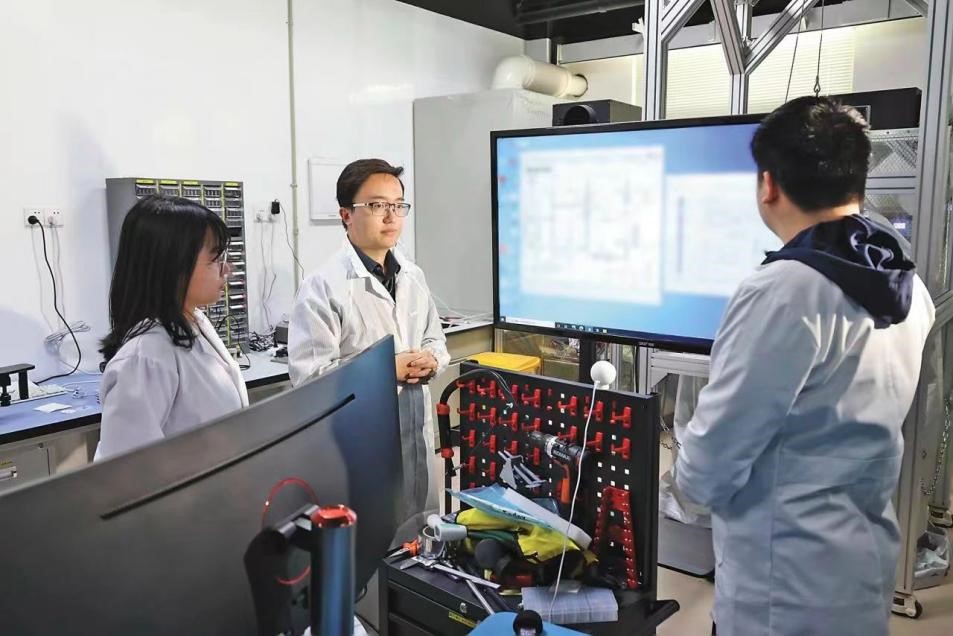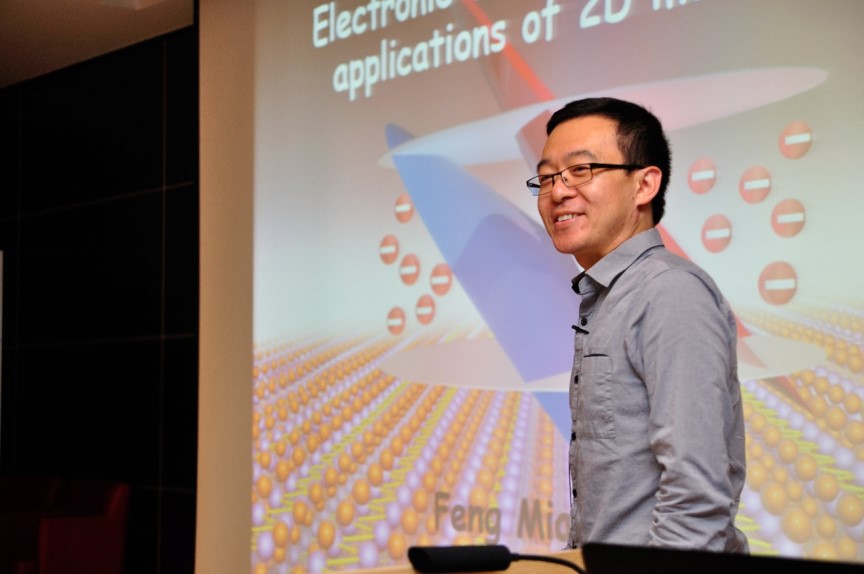Jiangsu builds "experimental fields" of basic research to unleash vitality for innovation
In June 2023, east China's Jiangsu province planned to establish three basic science centers as part of its efforts to deepen reforms in the scientific and technological system and talent development mechanisms.
These centers, focusing on physics, applied mathematics, and synthetic biology, are being piloted in research universities and other scientific institutions to reform the basic research system. In just one year, a number of groundbreaking results have emerged from these young "experimental fields" of basic research.
Among them, the provincial center for physics science (PCPS) in Jiangsu province, which is backed by Nanjing University, has made significant strides in original research.

Professor Du Lingjie (middle) with the School of Physics, Nanjing University, joins a discussion with his students. (Photo/Li Jiahao)
At the quantum extreme measurement laboratory of the School of Physics, Nanjing University, professor Du Lingjie and his doctoral students are at the forefront of innovative research. Every day, they search for signals of new quasi-particles from excitation peaks, akin to finding a needle in a haystack.
In their experiments, the flickering red laser beams keep changing energy levels, striking semiconductor samples in a cooling machine. The signals are instantly captured and displayed on a computer screen as excitation peaks that look like an electrocardiogram. Each peak represents a collision between an electron and a photon.
The team examines hundreds of these excitation peaks per day, trying to identify the elusive signals. "Where is the signal? What does it look like? How long will it take to find it?" These are the questions that drive their research, with no guarantees of success.
In the first half of 2023, Du and his team encountered challenges in their research: experiments that needed to be redesigned, a need for continuous capital input, and unknown prospects of the studies. This entirely new research was not included in any scientific project guidelines. Despite these challenges, Du received unwavering support from Wang Bogen, dean of the School of Physics, Nanjing University.
Wang's confidence came from the commitment of China's "experimental fields" to reforming the scientific and technological system. This reform grants researchers substantial autonomy in their scientific pursuits and encourages them to "propose new theories, pioneer new fields, explore new paths, and focus on independent innovation."
In 2023, Jiangsu province invested 130 million yuan ($18.14 million) to establish three basic research centers - the PCPS and other two provincial centers for applied mathematical sciences and foundational research in synthetic biology, among which the PCPS received a funding of 50 million yuan.

Photo shows Miao Feng, a professor with the School of Physics, Nanjing University. (Photo provided by Miao Feng)
"The strong research support and sufficient financial guarantee were like a lifeline for our research," said Du. On March 28 this year, their significant research findings were published on Nature. This marked the world's first discovery of quasi-particles with graviton-like characteristics in real systems.
At a future computing laboratory of the PCPS, a four-layer "atomic building block" electronic device is clearly visible under a microscope. This groundbreaking development is the work of professor Miao Feng's research team from the School of Physics, Nanjing University.
"In traditional materials, electrons move without a unified direction. However, when in the topological edge states of quantum matter they move in a consistent direction, much like vehicles on a highway," said Miao.
His team has successfully integrated this "highway" concept into "atomic building blocks," constructing special electronic devices for brain-like computing. This significant achievement was recently published in the prestigious journal Nature Nanotechnology.
According to Ma Yuqiang, head and chief scientist of PCPS, project leaders are free to allocate research funds based on their judgment, which enables them to maximize the impact of limited resources, create cross-departmental, cross-disciplinary, and cross-industry teams, and bring together top talent.
Education, science and technology, and human resources are the foundational and strategic pillars for Chinese modernization. "The establishment and operation of the three basic science centers in Jiangsu province would help explore the integrated reform of education, science and technology, and talent systems, continuously unleash the inexhaustible drive for scientific research, and foster a vibrant atmosphere for innovation and creation," said Xu Guanghui, head of the Jiangsu Provincial Department of Science and Technology.
Photos
Related Stories
- Old industrial base sprints for revitalization through innovation
- China's central regions look to reform, innovation for high-quality development
- Continuous innovation injects growth momentum to Chinese enterprises
- Liaoning scraps its rusty past to shine as hub of innovation
- China launches 17 new consortiums to propel sci-tech innovation
Copyright © 2024 People's Daily Online. All Rights Reserved.









